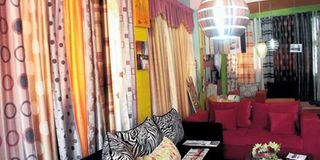How to prepare your home for sale

When it comes to window treatments, colour, fabric choice, design, lining, and length are what counts. To cosy up the place, use colourful drapes and curtains with solid hues as these gives the whole house a warmer appeal. PHOTO | NATION MEDIA GROUP
What you need to know:
- Home staging can be termed as giving your house a face-lift, cleaning and de-cluttering, and brightening rooms in order to prepare them for the scrutinising eyes of buyers and their agents.
- However, home staging goes beyond basic de-cluttering and painting, and if you are to succeed, you should also focus on the arrangements and moods of rooms and units in the house.
Are you planning to sell you house? If so, make sure it is in the best state before you put it in the market, because, if you don’t, you may end up getting really disappointed.
After 156 days of studying market patterns, Real Estate Staging Association, an American property organisation, found out that, out of the 174 houses that had been on the market for the 156 days of the study, only a paltry nine per cent were sold.
But, after hiring a professional home stager — a professional who prepares a private home for sale — all the remaining homes were sold within 42 days.
While there are no statistics in Kenya on the same, this certainly highlights the importance of staging your home right before putting it up for sale.
“It is like going out on a date, interview or an important meeting,” says Sarah Ndirangu, an interior designer. “You spruce up and spend hours making sure you look decent, if not radiant.”
According to her, while home staging is not popular here — largely because selling homes is not as popular locally compared to buying them — there are people who dock a few thousands off their properties’ value just because they did not spruce them up before putting them up for sale.
HOME STAGING
Home staging, says Ndirangu, can be termed as giving your house a face-lift, cleaning and de-cluttering, and brightening rooms in order to prepare them for the scrutinising eyes of buyers and their agents.
However, home staging goes beyond basic de-cluttering and painting, and if you are to succeed, you should also focus on the arrangements and moods of rooms and units in the house, as this is what gets into the mind and heart of the buyer before committing.
Nooks and crannies: The general rule is to give any nooks in your house an appealing look that won’t cause bias on the part of the buyer.
Instead of designating a nook as the dumping site for your dirty utensils, shoes or other household items, change it to, say, a bookshelf, library, study area, entertainment unit or even home office.
Dead wall spaces: “Nothing looks more sterile, boring and intimidating than a poorly painted wall with no hangings or other artwork to hide the imperfections,” offers Ndirangu. As décor is all about visual appeal, put a fresh coat of paint on these walls, then, to complete the look, dot them with hangings.
You may also use your flat screen TV, hanged appropriately on a wall in the living room, as a piece of art.
Bedroom neutrality: As you are not likely to be looking for buyers of a specific gender, ensure your rooms are gender-neutral, especially the master unit. Remove anything that magnifies certain gender aspects in the bedroom and instead adopt more simplistic and neutral décor objects.
If had painted your walls pink, coat them with more neutral colours like white or cream.
No empty room: People love homes that exude radiance and cheer, and an empty room is definitely not one of these.
Have furniture in every room, but not in patterns that will still highlight the presence of the previous owner once the new buyer moves in.
Window treatments: Blank windows give your house a sterile look. To cosy up the place, use colourful drapes and curtains with solid hues as these gives the whole house a warmer appeal.




